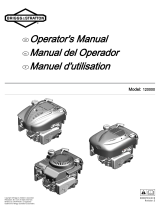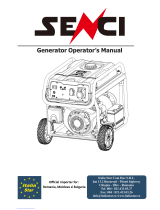
8 BRIGGSandSTRATTON.COM
Assembly
Your generator is ready for use after it has been properly serviced with the
recommended petrol and oil.
If you have any problems with the servicing of your generator, contact your local
Briggs & Stratton service center. If you need assistance, please have the model,
revision, and serial number from the identification label available. See Features
and Controls for identification label location.
Unpack Generator
1. Set the carton on a rigid, flat surface.
2. Remove everything from carton.
The generator is supplied with:
• Operator’s manual
• Wheel kit
• Bottle of engine oil
Install Wheel Kit Figure
1
NOTICE Wheel kit is not intended for over-the-road use.
Install the wheel kit as follows:
1. Tip generator so that engine end is up.
2. Slide a washer (A) over axle stud (B).
3. Slide a wheel (C) over axle stud (B).
NOTICE Be sure to install wheel with raised hub inboard.
4. Slide axle stud (B) through mounting bracket.
5. Insert retaining pin (D) through hole on axle stud.
6. Repeat steps 2 thru 5 to secure second wheel.
7. Line up holes in support leg (E) with holes in generator frame.
8. Attach support leg using four capscrews (F) and four flange nuts (G).
Tighten with 10 and 13 mm wrenches.
9. Return generator to normal operating position (resting on wheels and
support leg).
Add Engine Oil
1. Place generator on a level surface.
2. Add engine oil as described in Adding Engine Oil of the Engine
Maintenance section.
NOTICE
Improper treatment of generator could damage it and shorten its life.
• DO NOT attempt to crank or start the engine before it has been properly
serviced with the recommended oil. This could result in an engine failure.
Add Fuel Figure
2
Fuel must meet these requirements:
• Clean, fresh, unleaded petrol.
• A minimum of 87 octane/87 AKI (91 RON). For high altitude use, see High
Altitude.
• Petrol with up to 10% ethanol (gasohol) is acceptable.
NOTICE Use of unapproved fuels will damage the engine components and
void the engine warranty.
• DO NOT use unapproved petrol, such as E15 and E85.
• DO NOT mix oil in petrol or modify the engine to run on alternate fuels.
To protect the fuel system from gum formation, mix in a fuel stabilizer when
adding fuel. See Storage. All fuel is not the same. If you experience starting
or performance problems after using fuel, switch to a different fuel provider
or change brands. This engine is certified to operate on petrol. The emission
control system for this engine is EM (Engine Modifications).
1. Clean area around fuel fill cap, remove cap.
2. Slowly add unleaded fuel to fuel tank. Be careful not to fill above the red
fuel level indicator (A). This allows adequate space for fuel expansion
as shown.
3. Install fuel cap and let any spilled fuel evaporate before starting engine.
High Altitude
At altitudes over 1500 meters (5,000 feet), a minimum 85 octane / 85 AKI
(89 RON) petrol is acceptable. To remain emissions compliant, high altitude
adjustment is required. Operation without this adjustment will cause decreased
performance, increased fuel consumption, and increased emissions. See a
Briggs & Stratton authorized dealer for high altitude adjustment information.
Operation of the engine at altitudes below 750 meters (2,500 feet) with the
high altitude kit is not recommended.
System Ground
The generator is provided with a grounding fastener. The generator has a
system ground that connects the generator frame components to the ground
terminals on the AC output receptacles. The system ground is connected to
the AC neutral wire (the neutral is bonded to the generator frame).
Special Requirements
There may be Federal, local codes, or ordinances that apply to the intended
use of the generator. Please consult a qualified electrician, electrical inspector,
or the local agency having jurisdiction:
• In some areas, generators are required to be registered with local utility
companies.
• If the generator is used at a construction site, there may be additional
regulations which must be observed.
Connecting to a Building’s Electrical System
Connections for standby power to a building’s electrical system must use a
listed transfer switch installed by a current licensed electrician. The connection
must isolate the generator power from the utility power and must comply with
all applicable laws and electrical codes.
Generator Location
Before starting the portable generator there are two equally important safety
concerns regarding carbon monoxide (CO) poisoning and fire that must be
addressed.
NOTICE Satisfying the RISK OF CARBON MONOXIDE POISONING location
requirements may not satisfy the fire location requirements. Satisfying
the RISK OF FIRE location requirements may not satisfy the CARBON
MONOXIDE POISONING location requirements.
Operation Location of Portable Generator to REDUCE THE RISK OF
CARBON MONOXIDE POISONING
All fossil fuel burning equipment, such as a portable generator, contains
carbon monoxide (CO) gas in the engine exhaust, a poisonous gas that could
kill you in minutes. You CANNOT smell it, see it, or taste it. Even if you do not
smell exhaust fumes, you could still be exposed to carbon monoxide gas. The
following must be completed prior to starting the portable generator engine:
WARNING
Generator voltage could cause electrical shock or burn
resulting in death or serious injury.
• Use approved transfer equipment to prevent backfeed by isolating
generator from electric utility workers.
• When using generator for backup power, notify utility company.
• DO NOT connect generator to a building’s electrical system.
• Use a residual current circuit breaker with overload protection device
(RCBO) in any damp or highly conductive area, such as metal decking or
steel work.
• DO NOT touch bare wires or receptacles.
• DO NOT use generator with electrical cords which are worn, frayed, bare
or otherwise damaged.
• DO NOT operate generator in the rain or wet weather.
• DO NOT handle generator or electrical cords while standing in water,
while barefoot, or while hands or feet are wet.
• DO NOT allow unqualified persons or children to operate or service
generator.
WARNING Fuel and its vapors are extremely flammable and explosive
which could cause burns, fire or explosion resulting in
death or serious injury.
WHEN ADDING FUEL
• Turn generator engine OFF and let it cool at least 2 minutes before removing
fuel cap. Loosen cap slowly to relieve pressure in tank.
• Fill fuel tank outdoors.
• DO NOT overfill tank. Allow space for fuel expansion.
• If fuel spills, wait until it evaporates before starting engine.
• Keep fuel away from sparks, open flames, pilot lights, heat, and other
ignition sources.
• Check fuel lines, tank, cap and fittings frequently for cracks or leaks.
Replace if necessary.
• DO NOT light a cigarette or smoke.





















